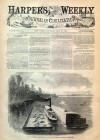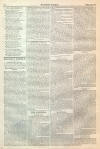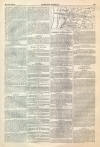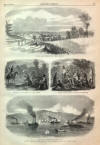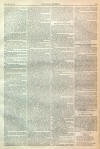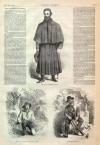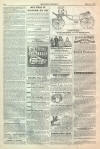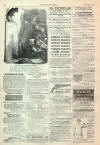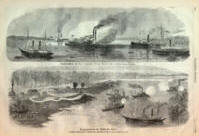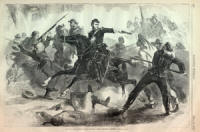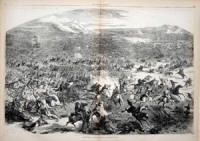Death of Stonewall Jackson
|
|
This Site:
|
MAY 30, 1863.] HARPER'S WEEKLY. 349 GEN. STONEWALL JACKSON.WE publish herewith a portrait of the late THOMAS JEFFERSON JACKSON, better known as "Stonewall Jackson," in his lifetime a Lieutenant-General in the rebel army. He was born about the year 1826, in Lewis County, Virginia, and entered West Point in 1842. He graduated in 1846, in the same class with Generals MClellan, Stoneman, Couch, Foster, etc., and entered the Second Artillery. He went with his regiment to Mexico, fought gallantly throughout the campaign, and received three brevets for his conduct at the battles of Contreras, Churubusco, and Chapultepec. After the war he left the army with the rank of Major, and became a Professor of Mathematics at the Military Institute of Lexington, Virginia. While there he married the daughter of Rev. George Junkin, now of New York, and identified himself with the Presbyterian Church. His wife dying, he espoused a daughter of Rev. Dr. Morrison, of Davidson College, North Carolina. At the outbreak of the war Major Jackson is said to have had some difficulty in deciding where the path of duty lay; but eventually evil counsels prevailed, and he cast his lot with the rebels. The following is an accurate and succinct account of his military career: He was at first placed at the head of a regiment of infantry, which he drilled so quickly, and yet so perfectly, as to rely upon them at any moment. With this regiment he engaged General Patterson's forces at Falling Waters on the 2d of July, 1861; but the contest resulted in a mere skirmish. At the battle of Bull Run, July 21, 1861, he was asked by General Beauregard whether—his troops being raw—he thought they would be likely to stand. "Yes," he answered, "like a stone-wall;" and stand they did till the end of the contest. From this answer he obtained the sobriquet of "Stonewall Jackson," which has stood by him to the last. He lost a horse during the battle, it being shot while he was upon him, and a bullet is said to have taken off a finger of his left hand. From the date of this battle he became noted among his fellows, and he was placed in command of a brigade. He displayed such skill in its organization that he was allowed a separate command to operate in the Shenandoah Valley region. On the 22d and 23d of March, 1862, he engaged the forces of General Shields at Winchester, and fought them from behind a stone-wall. On the first day General Shields repulsed him; but, being reinforced, Jackson again engaged Shields with redoubled vigor at sunrise the next morning. General Shields would have been beaten, as desperate was the onslaught, but for the timely arrival of a brigade from General Williams's division. Thus reinforced, General Shields attempted to turn his flank, but was met by a veritable stone-wall, behind which. the rebels picked off numbers of our men. Subsequently, by a desperate assault, the rebel forces were finally driven from the position, but not, considering the numbers engaged, until a fearful slaughter had taken place on both sides. For some time General Jackson was engaged only in trifling operations at the upper end of the Shenandoah Valley, the change of operations of General McClellan's advancing army requiring him to be on the qui vive for a movement to some other quarter of Virginia. On the 8th of May he made a dash upon the advanced positions of Generals Milroy and Schenck, at the town of McDowell, east of the Alleghanies. After this be set the report afloat that he intended to attack Fredericksburg, then held by General McDowell's corps. While the Union troops in the Shenandoah Valley were congratulating themselves upon the idea that Jackson was not in their front, he suddenly dashed upon their advance, under Colonel Kenly, at Front Royal, near one of the gaps of the Blue Ridge. This was on the 23d of May, 1862, and the success of the movement is too recent in the memory of our readers to need more than a passing notice. For the next three days he was engaged in the pursuit of the weakened forces under General Banks, whose masterly retreat saved his army from the fate that befell Colonel Kenly. Banks's forces being reinforced, Jackson steadily retreated before them up the valley. On the 31st of May and 1st of June he was closely pursued by the forces of Generals Banks, Shields, and Fremont, operating from different directions, and it was then believed that he would be captured with his whole force. It was not properly understood what manner of man had to be dealt with in this pursuit; but it was shortly afterward demonstrated; for on the 8th of June he turned upon his pursuers and engaged Fremont's wing, embracing the forces under Generals Schenck, Milroy, and Blenker. These forces he compelled to give up the pursuit, and the next day he attacked those under General Shields, at Port Republic, likewise causing them to fall back. By the celerity of his movements he prevented the junction of the pursuing forces, and retreated to Richmond to join in the attack upon McClellan. For this operation General Jackson was made a Major-General of the rebel regular army. Leaving a small portion of his forces to amuse the troops in the Shenandoah Valley, he removed his main army, which was further reinforced, to Mechanicsville, near the Upper Chickahominy River. Here he attacked the right wing of General McClellan's army on the 25th of May, following up the attack on the 26th against General McCall, and on the 27th upon General Fitz John Porter, at Gaines's Mill. There is but little doubt that he took an active part in the various battles of that eventful period. He was reported slightly wounded; but the report has not since been definitely substantiated. After McClellan's retreat to Harrison's Landing he moved with his usual swiftness toward the Upper Rappahannock. Here for several days he operated against the forces of General Pope's Army of Virginia. These operations finally culminated in the desperate battle of Cedar Mountain, where General Banks stubbornly resisted his onslaught, and inflicted on the rebel army a loss of nearly two thousand men. Finally, as General Pope, during the remainder of August, fell back upon Washington, General Jackson's forces were more or less engaged in the battles incident to that retreat, especially in the raid around the Union army, where he destroyed General Pope's baggage and secured a large amount of spoil. When Lee's army advanced into Maryland Jackson was appointed to operate along his old ground—the Shenandoah Valley—to clear the Union forces out of that region. He made a demonstration upon Martinsburg, then under General Julius White, causing that force to fall back upon Harper's Ferry, and then, by a combination with forces on the Maryland side of the Potomac, besieged for several days the key of the valley—Harper's Ferry. His was the master mind in this siege, and finally this position capitulated on the 15th day of September, 1862, with all its stores, armament, munitions, and men. Again he moved his command with celerity, and on the night of the 16th he is reported by General Hooker to have had his forces added to those of General Lee, on the banks of Antietam Creek, and to have participated in that severe contest for the possession of Maryland. After the rebel army had been driven out of Maryland, Jackson's forces, with Lee's, moved southward toward the Rappahannock, and when General Sumner made his rapid movement to the Rappahannock, General Jackson's forces also moved rapidly to keep up with it, arriving in Fredericksburg shortly after Sumner occupied Falmouth. Had the pontoon bridges been ready General Sumner would have occupied the position first, and the slaughter of December 13 might have been avoided. General Jackson held command of the right wing during that fearful contest, and repulsed the left wing of Burnside's army, under General Franklin. For this victory he was promoted to a lieutenant-generalship, a rank equal to our commander of a corps. For some time after this battle he was reported sick; but it plainly appears that, sick or well, he was on the field at Chancellorsville. At this, his last battle, he again demonstrated his power of moving with celerity. When the movement of Hooker's army first commenced, at the latter end of April, Jackson's command was at Port Royal, on the extreme right of the rebel line, and here he faced the advance of Reynolds's corps. Perceiving this was a feint, he pushed his command across the country, and on the 1st of May attacked with great determination the extreme right of the Union army. Again moving with remarkable quickness, he on the 3d of May attacked the forces under General Sedgwick at Salem Heights, the position being about the centre of the rebel line and the left of ours. He was wounded during this engagement, taken from the field, and his wound attended to by one of the most experienced surgeons of the South; but amputation of the arm was necessary. The operation, combined with other causes, resulted in his death, which took place on Sunday, May 9. The Herald publishes the following characteristic anecdotes of the man: He had in his service a negro who had become so used to his ways as to know when he was about to start on an expedition without receiving any notice from his master. When asked how he could know that, as his master never talked about his plans, the negro answered, "Massa Jackson allers prays ebery night and ebery mornin'; but when (Next Page) THE LATE "STONEWALL" JACKSON.THE SCOUT DAVIDSON ON DUTY.—[SEE PAGE 343.]OFF DUTY.—[SEE PAGE 343.]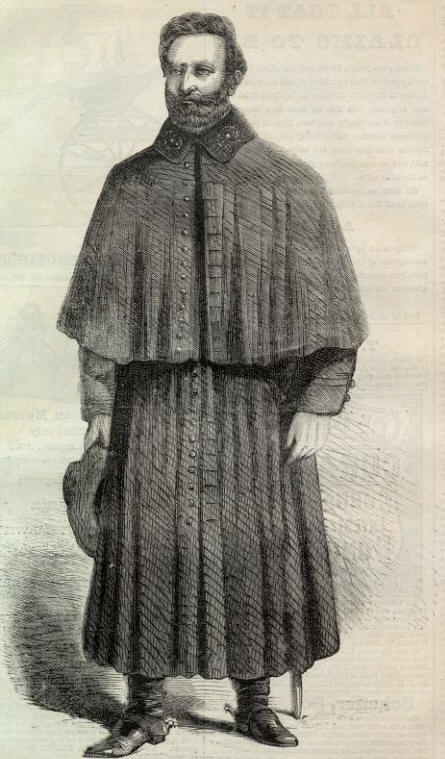 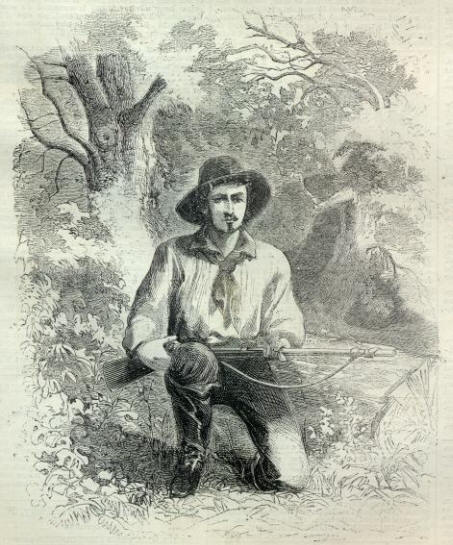  |
||||||||||||||||||||||
|
|
||
|
|
Site Copyright 2003-2018 Son of the South. For Questions or comments about this collection, contact paul@sonofthesouth.net |
|
|
Are you Scared and Confused? Read My Snake Story, a story of hope and encouragement, to help you face your fears. |
||
